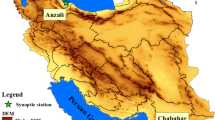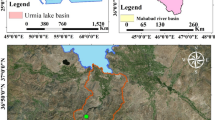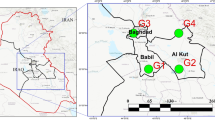Abstract
The advancements of artificial intelligence models have demonstrated notable progress in the field of hydrological forecasting. However, predictions of extreme climate events are still a challenging task. This paper presents the development and verification procedures of a new hybrid intelligent model, namely convolutional long short-term memory (CNN-LSTM) for short-term meteorological drought forecasting. The CNN-LSTM conjugates the long short-term memory (LSTM) network with a convolutional neural network (CNN) as the feature extractor. The new model was implemented to forecast multi-temporal drought indices, three-month and six-month standardized precipitation evapotranspiration (SPEI-3 and SPEI-6), at two case study points located in Ankara province, Turkey. Statistical accuracy measures, graphical inspections, and comparison with benchmark models, including genetic programming, artificial neural networks, LSTM, and CNN, were considered to verify the efficiency of the proposed model. The results showed that the CNN-LSTM outperformed all the benchmarks. In quantitative visualization, it attained minimal root mean square error (RMSE = 0.75 and 0.43) for the SPEI-3 and SPEI-6 at Beypazari station and (RMSE = 0.73 and 0.53) for the SPEI-3 and SPEI-6 at Nallihan station over the testing periods. The proposed hybrid model was a promising and reliable modeling approach for the SPEI prediction and increased our knowledge about meteorological drought patterns.











Similar content being viewed by others
Explore related subjects
Discover the latest articles, news and stories from top researchers in related subjects.Data availability
The source codes/data used in this article are available at https://github.com/alidanandeh/CNN-LSTM.
References
Abd Elaziz M, Elsheikh AH, Oliva D, Abualigah L, Lu S (2021b) Ewees AA (2021) Advanced metaheuristic techniques for mechanical design problems. Arch Comput Methods Eng. https://doi.org/10.1007/s11831-021-09589-4
Abd Elaziz M, Dahou A, Abualigah L, Yu L, Alshinwan M, Khasawneh AM, Lu S (2021) Advanced metaheuristic optimization techniques in applications of deep neural networks: a review. Neural Comput & Applic 33: 14079–14099. https://doi.org/10.1007/s00521-021-05960-5
Abualigah, L., Abd Elaziz, M., Sumari, P., Geem, Z. W., & Gandomi, A. H. (2022). Reptile Search Algorithm (RSA): A nature-inspired meta-heuristic optimizer. Expert Systems with Applications, 191, 116158.
Ahmadalipour A, Moradkhani H, Demirel MC (2017) A comparative assessment of projected meteorological and hydrological droughts: elucidating the role of temperature. J Hydrol 553:785–797. https://doi.org/10.1016/j.jhydrol.2017.08.047
Akande KO, Owolabi TO, Twaha S, Olatunji SO (2014) Performance comparison of SVM and ANN in predicting compressive strength of concrete. IOSR J Comput Eng 16(5):88–94. https://doi.org/10.9790/0661-16518894
Ardabili S, Mosavi A, Dehghani M, Várkonyi-Kóczy AR (2019) Deep learning and machine learning in hydrological processes climate change and earth systems a systematic review. In: International conference on global research and education, Springer, Cham, pp 52–62. https://doi.org/10.1007/978-3-030-36841-8_5
Bacanli UG, Firat M, Dikbas F (2009) Adaptive neuro-fuzzy inference system for drought forecasting. Stoch Environ Res Risk Assess 23:1143–1154. https://doi.org/10.1007/s00477-008-0288-5
Banerjee R, Ghose A, Mandana KM (2020). A hybrid CNN-LSTM architecture for detection of coronary artery disease from ECG. In: 2020 International Joint Conference on Neural Networks (IJCNN), IEEE, pp 1–8. https://doi.org/10.1109/IJCNN48605.2020.9207044.
Barua S, Ng AWM, Perera BJC (2012) Artificial neural network–based drought forecasting using a nonlinear aggregated drought index. J Hydrol Eng 17(12):1408–1413. https://doi.org/10.1061/(ASCE)HE.1943-5584.0000574
Beyaztas U, Yaseen ZM (2019) Drought interval simulation using functional data analysis. J Hydrol 579:124141. https://doi.org/10.1016/j.jhydrol.2019.124141
Bhalme HN, Mooley, DA (1980). Large-scale droughts/floods and monsoon circulation. Mon Weather Rev 108(8): 1197–1211. http://moeseprints.incois.gov.in/id/eprint/1351
Danandeh Mehr A, Sorman AU, Kahya E, Hesami Afshar M (2020) Climate change impacts on meteorological drought using SPI and SPEI: case study of Ankara. Turkey Hydrol Sci J 65(2):254–268. https://doi.org/10.1080/02626667.2019.1691218
Deenadayalan V, Vaishnavi P (2021) Improvised deep learning techniques for the reliability analysis and future power generation forecast by fault identification and remediation. J Ambient Intell Human Comput. https://doi.org/10.1007/s12652-021-03086-z
Dehghani M, Saghafian B, Nasiri Saleh F, Farokhnia A, Noori R (2014) Uncertainty analysis of streamflow drought forecast using artificial neural networks and Monte-Carlo simulation. Int J Climatol 34(4):1169–1180. https://doi.org/10.1002/joc.3754
Deo RC, Tiwari MK, Adamowski JF, Quilty JM (2017) Forecasting effective drought index using a wavelet extreme learning machine (W-ELM) model. Stoch Environ Res Risk Assess 31(5):1211–1240. https://doi.org/10.1007/s00477-016-1265-z
Hendawitharana SU, Priyasad D, Rajapakse RLHL (2018) Sub-basin Scale Drought Forecasting with Standard Precipitation Index by using Remotely Sensed Precipitation & LSTM. In: 2018 18th international conference on advances in ICT for emerging regions (ICTer) IEEE, pp 1–1. https://doi.org/10.1109/ICTER.2018.8615519.
Hochreiter S, Schmidhuber J (1997) Long Short-Term Memory Neural Compu 9(8):1735–1780. https://doi.org/10.1162/neco.1997.9.8.1735
Hrnjica B, Danandeh Mehr A (2018) Optimized genetic programming applications: emerging research and opportunities. IGI global. PA. pp 1–310.
Hrnjica B, Mehr, AD (2020) Energy demand forecasting using deep learning. In: Al-Turjman F. (eds) Smart Cities Performability, Cognition, & Security. EAI/Springer Innovations in Communication and Computing. Springer, Cham, pp 71–104, https://doi.org/10.1007/978-3-030-14718-1_4
Li T, Hua M, Wu XU (2020) A hybrid CNN-LSTM model for forecasting particulate matter (PM2. 5). IEEE Access 8:26933–26940. https://doi.org/10.1109/ACCESS.2020.2971348
Ma L, Tian S (2020) A hybrid CNN-LSTM model for aircraft 4D trajectory prediction. IEEE Access 8:134668–134680. https://doi.org/10.1109/ACCESS.2020.3010963
McKee, TB, Doesken NJ, Kleist J (1993) The relationship of drought frequency and duration to time scales. In: Proceedings of the 8th conference on applied climatology. Boston.
Mehr AD, Vaheddoost B (2020) Identification of the trends associated with the SPI and SPEI indices across Ankara. Turkey Theor Appl Climatol 139(3):1531–1542. https://doi.org/10.1007/s00704-019-03071-9
Mehr AD, Kahya E, Özger M (2014) A gene–wavelet model for long lead time drought forecasting. J Hydrol 517:691–699. https://doi.org/10.1016/j.jhydrol.2014.06.012
Mehran A, Mazdiyasni O, AghaKouchak A (2015) A hybrid framework for assessing socioeconomic drought: linking climate variability, local resilience, and demand. J Geophys Res 120(15):7520–7533. https://doi.org/10.1002/2015JD023147
Miao, T (2018) Research of regional drought forecasting based on phase space reconstruction and wavelet neural network model. In: 2018 7th International conference on agro-geoinformatics (Agro-geoinformatics) IEEE, pp 1–4. https://doi.org/10.1109/Agro-Geoinformatics.2018.8475999.
Palmer WC (1965) Meteorological drought. Vol. 30. US Department of Commerce, Weather Bureau.
Şahin CB, Abualigah L (2021) A novel deep learning-based feature selection model for improving the static analysis of vulnerability detection. Neural Comput Applic 33:14049–14067. https://doi.org/10.1007/s00521-021-06047-x
Shen C (2018) A transdisciplinary review of deep learning research and its relevance for water resources scientists. Water Resour Res 54(11):8558–8593. https://doi.org/10.1029/2018WR022643
Soh YW, Koo CH, Huang YF, Fung KF (2018) Application of artificial intelligence models for the prediction of standardized precipitation evapotranspiration index (SPEI) at Langat River Basin, Malaysia. Comput Electron Agric 144:164–173. https://doi.org/10.1016/j.compag.2017.12.002
Vicente-Serrano SM, Beguería S, López-Moreno JI (2010) A multiscalar drought index sensitive to global warming: the standardized precipitation evapotranspiration index. J Climate 23(7):1696–1718. https://doi.org/10.1175/2009JCLI2909.1
Vinyals O, Toshev A, Bengio S, Erhan D (2015) Show and tell: A neural image caption generator. In Proceedings of the IEEE conference on computer vision and pattern recognition, pp. 3156–3164.
Yaseen ZM, El-Shafie A. Jaafar O, Afan HA, Sayl KN (2015) Artificial intelligence based models for stream-flow forecasting: 2000–2015. J Hydrol 530: 829-844. https://doi.org/10.1016/j.jhydrol.2015.10.038
Yaseen ZM, Awadh, SM. Sharafati A, Shahid S (2018). Complementary data-intelligence model for river flow simulation. J Hydrol 567: 180-190. https://doi.org/10.1016/j.jhydrol.2018.10.020
Yusuf SA, Samad A, Garrity DJ (2019) CLEverReg: A CNN-LSTM based Linear Regression Technique for Temporal Fire Event Modelling. In: 2019 international joint conference on neural networks (IJCNN) IEEE, pp. 1–7 https://doi.org/10.1109/IJCNN.2019.8852152.
Zargar A, Sadiq R, Naser B, Khan FI (2011) A review of drought indices. Environ Rev 19(NA): 333–349. https://doi.org/10.1139/a11-013
Acknowledgements
The authors appreciate the editors and four anonymous reviewers for their fruitful comments on this paper. Special thanks to Nasrin Fathollahzadeh Attar for her help on visualization of Taylor diagrams. We also thank the Turkish State of Meteorological Service for the meteorological data used in this study.
Funding
No funds, grants, or other support was received.
Author information
Authors and Affiliations
Contributions
ADM: conceptualization, supervision, methodology, formal analysis, resources, data curation, visualization, writing original draft, review, and edit. ARG: methodology, formal analysis, writing original draft, review, and edit. ZMY: formal analysis, writing original draft, visualization, review, and edit. AUS: writing original draft, review, and edit. LA: writing original draft, visualization, review, and edit.
Corresponding authors
Ethics declarations
Conflict of interest
The authors have no conflicts of interest or competing interests.
Additional information
Publisher's Note
Springer Nature remains neutral with regard to jurisdictional claims in published maps and institutional affiliations.
Rights and permissions
About this article
Cite this article
Danandeh Mehr, A., Rikhtehgar Ghiasi, A., Yaseen, Z.M. et al. A novel intelligent deep learning predictive model for meteorological drought forecasting. J Ambient Intell Human Comput 14, 10441–10455 (2023). https://doi.org/10.1007/s12652-022-03701-7
Received:
Accepted:
Published:
Issue Date:
DOI: https://doi.org/10.1007/s12652-022-03701-7




